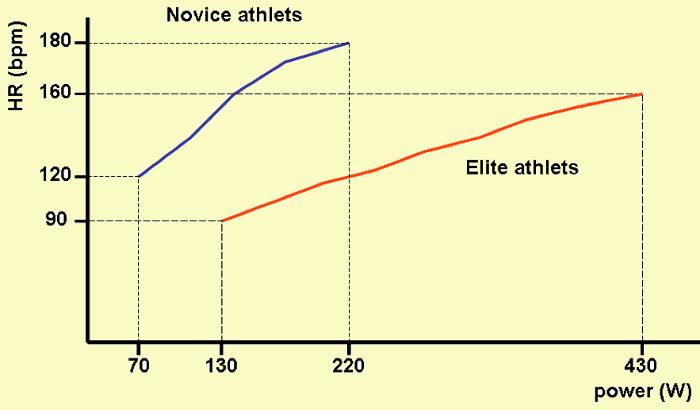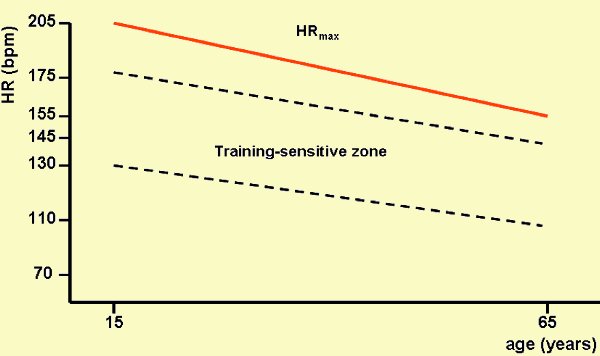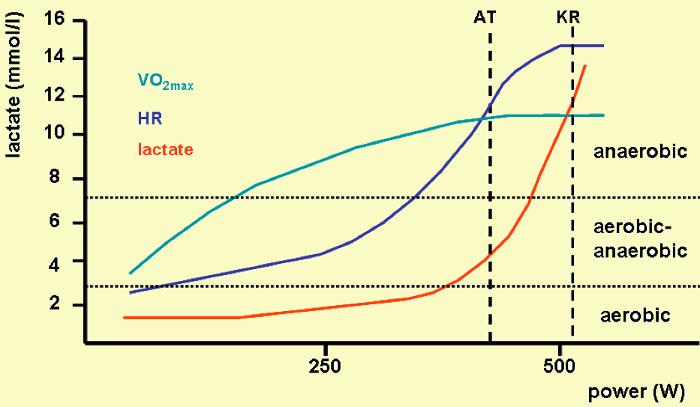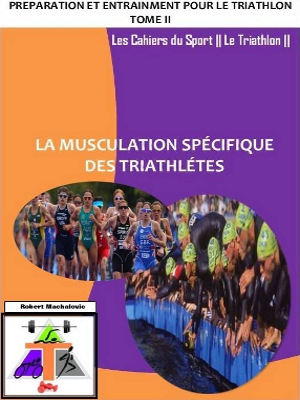Heart Rate
Hear rate represents the most accessible indicator of heart-circulatory system load. It is most sensitive to any increase in intensity and increase in resistance. Hear rate represents a reliable magnitude for judging load intensity.
With increasing load, e.g. in case of gradual increase in speed of running, hear rate increases. With increased load, increase heart rate of elite athletes is much slower than with athletes at a lower performance level due to better level of training . Based on increasing training, there appear a number of structural and functional changes in the organism. Structural changes of the heart muscle during long-term loading directly affect heart rate. As a result of long-term and systematic loading, the heart chambers get larger and the strength of myocardium gets better. The more the heart got adapted with training, the lower its rate while loaded is. Thus, resting heart rate of well-trained athletes is much lower than untrained individuals. The heart rate of an untrained person is approximately 70 beats per minute while the heart rate of a well-trained athlete is as low as 35 beats per minute. This phenomenon is referred to as bardicardia. In comparison with men, the heart rate of women is usually higher.

Example of increase in heart rates of elite and novice athletes
Heart rate is affected by a number of factors. The most prominent of these are:
- Age and sex
- Sports performance
- Size of heart
- Health condition
Age and sex
Resting heart rate tells about the condition of vegetative nervous system and the level of training sensitively. Resting heart rate is usually taken palpably in the morning after wake-up in lying position for a period of 10 seconds. The value taken is multiplied by six. Resting hear rate of children is usually about 10 beats per minute higher than in adults. Maximal heart rate lowers generally with age. The following formula can be used to tell informative maximal heart rate:
HRmax = 220 - age ± 15 beats/min
Using the values of maximal heart rate, individual training zones for developing endurance can be inferred

Relationship between maximal heart rate and age
Size of heart
As a result of repeated systematic loading, the heart (heart volume) grows bigger. Changes in the volume of the heart start to be manifested after eight weeks of regular training with weekly training volume of more than 10 hours. The size of heart is assessed with heart quotient (heart volume/kg). If heart quotient exceeds the value of 13 in men and 12 in women, we refer to it as "sports heart". With one beat, a trained heart can deliver a bigger amount of blood into the bloodstream and therefore it can work in lower rate at the same load than untrained heart.
Sports performance
Resting heart rate or heart rate during a familiar competition load tells about the current level of training. Decrease in heart rate at a comparably same training load is a sign of increase in performance. Example: if I run on a treadmill regulary at the same speed, the level of my individual performance will rise gradually with this kind of load. Better performace is manifested in lower heart rate if compared with the condition before the start of regular training.
Health condition
Resting heart rate provides information on important physical changes which realte to health condition. If resting heart rate increases by more than 8 beats per minute during training period and the athlete is unwilling to be exposed to further training due to a feeling of exhaustion, it is a sign of illness.
Lactate
Lactate as lactate acid represents a significant load indicator. It cannot be measured as easily during training as heart rate (e.g. palpably or with heart rate monitor). Lactate can be diagnosed in laboratory conditions, e.g. in Ostrava University Human Motion Diagnostic Centre.
In human body, lactate is constantly present in the concentration of 0.5-2.2 mmol/l. When lactate appears, it is always a sign of overload of aerobic energy repletion and the start of anaerobic metabolism. Surplus appears with motor activities of maximum or sabmaximum intensity. An increased level of lactate starts to be manifested at the level of 50% to 60% of maximal oxygen consumption (VO2max) in untrained individuals, and at the level of 70% to 80% in trained athletes.
According to the amount of lactate in blood and depending on the intensity of motor activity, the dominan system of energy repletion can be estimated:
- < 2 mmol/l aerobic (slow glycolysis, oxidative system)
- 3 – 7 mmol/l aerobic-anaerobic (slow glycolysis, fast glycolysis)
- > 7 mmol/l anaerobic (fast glycolysis, phosphagen system)
Lactate concentration in blood does not reach maximum values immediately after finishind motor activity but it keeps increasing even afterwards. As a rule, maximum value of lactate in blood is reached between the third and tenth minutes of rest.
Oxygen consumption
Maximal oxygen consumption (VO2max) represents the ability of the organism to receive oxygen, transport and use it. Maximal oxygen consumption is expressed in units (ml/kg/min) or in units of absolute consumption (L/min). In training practice, aerobic capacity is used which is expressed in v % VO2max. Aerobic capacity expresses what share of maximal oxygen consumption is used for aerobic energy repletion. Functionally, it means to work as long as possible in a steady state, within prevailing aerobic mode without significant accumulation of lactate in muscles. During a race, the best endurance athletes are able to work for 10-15 minutes at the level of 95-98 % VO2max, with longer activities lasting 20-40 minutes at the level of 90 – 95 % and in a race which exceeds one hour, usually below 90 % of maximal aerobic performance.
In ordinary population, the average value of maximal oxygen consumption is around 45 ml/kg/min in men and 35 ml/kg/min in women. Top elite athletes exceed VO2max values 78 ml/kg/min in men and 68 ml/kg/min in women. In performance sports, the value of VO2max should be as close to the above values as possible.
Respiratory exchange ratio (RER)
Energy consumption is related to the intensity of motor activity. With increasing load, energy consumption increases and so does oxygen consumption. The ration of eliminating carbon dioxide (CO2) and oxygen intake (O2) makes respiratory exchange ratio (RER).
On the basis of measured values of RER, it can be estimated which energy substrate is currently used as a source of energy. Table 4 offers an overview of the values of respiratory exchange ratio.
Respiratory exchange ratio in different kind of metabolism
RER metabolism
1.0 carbohydrates
0.9 carbohydrates-fats
0.8 fats-carbohydrates
0.7 fats
Load indicators dynamics
Load indicators (heart rate, VO2max, lactate) are very much sensitive to change in load intensity. For better understanding, it is good to imagine a runner on a running ergometer who will be subject to gradual increase in speed of the ergometer in regular intervals. Heart rate will gradually increase depending on the speed of running up to the value of critical inentsity. Heart rate is not further increased beyond the value of critical intensity. The rising of the heart rate curve will be the slower, the more trained the runner is. Heart rate curve will steadily rise up to the value of critical intensity. Lactate curve will first be kept at the same level which is a proof that energy repletion is done in aerobic way (slow glycolysis, aerobic system). From a certain point where aerobic processes do not suffice on, anaerobic processes of energy repletion (fast glycolysis) are employed more significantly. This is manifested in steep rise of the lactate curve. Load indicators dynamics is presented in Figure 9.

Load indicators dynamics during loading
Legend: VO2max- maximal oxygen consumption, HR- heart rate, AT- anaerobic treshold, KR-kritical intensity
Using load indicators in practice
The above indicators are able to be diagnosed in laboratory conditions. Spiroergometry represents a method suitable for diagnostics.
Example: during spiroergometrical examination, man (22 years of age) reached maximal values at the load of 482 W (set by speed and the angle of runningh ergometer), maximal heart rate 188 beats/min, maximal oxygen consumption 69.3 ml/kg/min and respiratory exchange ratio 0.98. For training preparation, the most important information is contained in AT column (anaerobic treshold). Hear rate value of 175 beats/min expresses the value of anaerobic threshold. Motor activity of intensity below 175 beats/min shifts training to the area of dominant aerobic metabolism. On the other hand, motor activity of intensity over 175 beats/min shifts training to the area of dominant anaerobic metabolism. Heart rate can easily be observed during training through heart rate monitors.

 Indicators of exercse load provide information on the condition of organism during training activity. They are sensitive to changes in the size of load. Among the indicators, there are:
Indicators of exercse load provide information on the condition of organism during training activity. They are sensitive to changes in the size of load. Among the indicators, there are:


